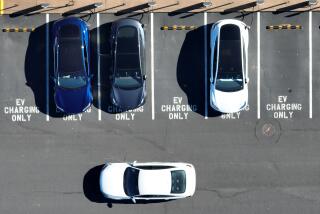Motorists help gas costs slide
- Share via
Gasoline prices skidded sharply lower during the last week partly because motorists have been curbing their driving -- cutting back so much that Transportation Secretary Mary E. Peters warned Monday of a looming shortfall in the fund that pays for highway and bridge construction and repairs.
The U.S. average price for a gallon of self-serve regular gasoline dropped below $4 a gallon for the first time since June 2, declining 10.9 cents a gallon to $3.955, according to the Energy Department’s weekly survey of filling stations. In California, the average fell 14.3 cents to $4.317 a gallon.
Fuel prices have been falling as lower oil prices make their way to the pump and because motorists are driving less.
Model and actress Risako Takahashi on Monday spent more than $62 to fill her 2002 Mazda Protege, or about $17 more per tank than it cost last year.
As a result, Takahashi has curtailed her driving by about 25%, having cut back on visits to her favorite Hollywood hangouts and seeing friends in Orange County, she said. Instead of driving to the beach and jogging on the sand, the 37-year-old Westwood resident runs in her neighborhood, and she walks to the grocery store instead of driving.
“It’s still amazingly expensive, so I just try to stay on the Westside now,” Takahashi said. “The only thing I won’t drive less for is an audition.”
In May, U.S. motorists drove 9.6 billion fewer miles, or 3.7% less, than in May 2007, according to a report on traffic volume trends released Monday by the Federal Highway Administration. It was the seventh consecutive monthly decline, suggesting that U.S. road travel will record the first annual drop since 1980.
The May total for vehicle miles traveled represented the third-biggest drop recorded in the 66 years that such figures have been tracked, the report said. The drop was particularly surprising because May is usually a big driving month, launching the summer car-trip season.
The numbers are so significant that officials have become concerned that the nation’s highway trust fund might not receive enough in gasoline and diesel tax revenue to maintain the country’s transportation infrastructure. The fund gets 18.4 cents per gallon of gasoline sold and 24.4 cents per gallon of diesel.
“By driving less and using more fuel-efficient vehicles, Americans are showing us that the highways of tomorrow cannot be supported solely by the federal gas tax,” Transportation Secretary Peters said in a statement.
“We must embrace more sustainable funding sources for highways and bridges through more sustainable and effective ways such as congestion pricing and private activity bonds.”
Also on Monday, the Energy Department said U.S. petroleum demand in May fell 4.3%, or 891,000 barrels a day, compared with May 2007, the lowest monthly demand in five years. The agency previously estimated that May demand fell 1.8%.
The reports sketched a picture of a fundamental change in American driving behavior that could be unprecedented, analysts said.
“This is only the first act in this opera, and if you think it was bad, wait until Acts 2 and 3,” said Fadel Gheit, senior energy analyst for investment firm Oppenheimer & Co. “Gasoline demand in 2009 will be less than it was in 2008.”
Tom Kloza, chief oil analyst for the Oil Price Information Service, believes that motorists are hitting the brakes permanently.
“I think we have tilted behavior to the point where this demand does not come back,” Kloza said.
On the New York Mercantile Exchange, crude oil for September delivery posted a $1.47 gain to $124.73 a barrel after reports of a rebel attack on a Nigerian pipeline owned by Royal Dutch Shell.
The cost of the U.S. benchmark crude hit a record $147.27 a barrel July 11. Worries about declining fuel demand in the U.S. have put a damper on prices since then. Still, oil prices are up 62% from a year earlier.
--
More to Read
Sign up for Essential California
The most important California stories and recommendations in your inbox every morning.
You may occasionally receive promotional content from the Los Angeles Times.











